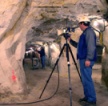
Tunnel Study Shows Promise for Better Emergency Communications
In a discovery that may lead to better communications in underground mines and subways, researchers at the National Institute of Standards and Technology have confirmed that underground tunnels can have a frequency "sweet spot" where signals may travel several times farther than at other frequencies, NIST announced Tuesday. They used new data to confirm models developed in the 1970s.
The optimal frequency depends on the dimensions of the tunnel. For a typical subway-sized tunnel, the sweet spot is in the frequency range 400 MHz to 1 gigahertz (GHz). The research was supported in part by the U.S. Department of Justice and the Department of Homeland Security; it is published in a NIST series contributing to the first comprehensive public data collection on radio transmissions in large buildings and structures(www.boulder.nist.gov/div818/81802/MetrologyForWirelessSys/).
NIST said the data will support the development of open standards for the design of optimal systems, especially for emergency responders, adding that NIST researchers "were surprised by how much farther signals at the optimal frequency traveled in above-ground building corridors, as well as underground." Lead author Kate Remley said the results may help in designing wireless systems that improve control of search-and-rescue robots in subways. Some hand-held radios used by emergency responders for voice communications already operate within the optimal range for a typical subway, between around 400 MHz and 800 MHz. To provide the broadband data transfer capability desired for search and rescue with video (a bandwidth of at least 1 MHz), a regulatory change would be needed, Remley said.
The tunnel studies were performed in 2007 at Black Diamond Mines Regional Park near Antioch, Calif. NIST said tunnels can channel radio signals in the right frequency range because they act like giant waveguides -- pipelike channels that confine and direct microwaves on integrated circuit wafers and in antenna feed systems and optical fibers. The channel shape reduces the losses caused when signals are absorbed or scattered by structural features.